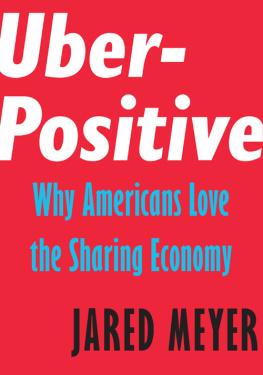Who will invent Americas next great century?
The big ideas that will revolutionize the way we live will not emerge from our nations capital. They will be dreamt up, as they always have been, by enterprising Americans who hope to create positive value for others.
Encounter Intelligence is dedicated to promoting advances in innovation, education, and technology that will improve the lives of all Americans and unlock real opportunity for those who need it most.
What Is the Sharing Economy?
Even in todays slow economic recovery, entire industries are transforming, consumers are more powerful than ever before, and people are finding new ways to earn a living. All of these improvements stem from the rise of the so-called sharing economy.
While much has been written about the novel business models of the sharing economy and the opportunities they create, the idea behind the sharing economy is nothing new. What sets these innovative companies apart from those of the past is their ability to use the Internet and smart phones to easily connect those who want something with those who have something to offer. The sharing economy offers easy access to an online platform that facilitates transactions between buyers and providers of goods or services.
Peer-to-peer online interaction, made available only recently by technological advances, is behind everything from eBay and Airbnb, to Zipcar and EatWith, to TaskRabbit and Uber. There have always been people who want to buy a hard-to-find product, find a place to stay, eat a home-cooked meal, get assistance on a task, or find a way to get around. The problem in the past was finding someone who was willing to offer the desired goods or services at a reasonable price. Imagine what it would have been like if people went from door to door and asked home owners if they had an extra room to rent and for how much. Now, travelers simply have to log on to Airbnb, and, with a few clicks of a mouse, they can find a room that fits their needs and budgets.
Before this technology existed, the difficulty of matching buyers with sellers led to the rise of many types of industries, such as the taxi dispatcher and travel agency, that built their business models around the lack of consumer empowerment. Now, with the sharing economys rapid expansion, these industries are facing increased competition. Rather than compete and adapt to the changing economy, some businesses work to stifle innovation through the political process.
Policy makers often fail to realize that a twenty-first-century economy cannot flourish while it is under the thumb of outdated laws and regulations.
Policy makers often fail to realize that a twenty-first-century economy cannot flourish while it is under the thumb of outdated laws and regulations. Economies grow through a dynamic process that necessitates change and disruption. Forcing new business models to comply with rules that were written decades ago is no way to promote entrepreneurship.
Groundbreaking business models are in danger of being suppressed because of overzealous government regulation that protects existing businessesall behind the faade of consumer protection. The question to ask with each new regulation is: who is actually being protectedthe public or special interests?
Through detailing the struggles that Ubera ride-sharing company that connects riders and drivers through a smart phone apphas faced in New York City, this monograph will show the promise of the sharing economy and the dangers of overregulation. Ubers experience and effect in New York City represent countless other battles being waged against the sharing economy across the globe. They also show that, when it comes to todays economy, it is more often than not special interests that are being protected when these businesses face undue regulationsat the expense of consumers.
The Rise (and Fall) of a Taxi King
Ride sharings success has made it clear that New York Citys yellow-taxi medallion system is outdated. In order for their drivers to accept street hails in downtown and midtown Manhattan, taxi owners must purchase one of the citys medallions. This nearly eighty-year-old relic restricts the number of yellow taxis to 13,437.
Anyone who has tried to hail a taxi during rush hour, in the rain, or late at night knows this cap is too low.
Medallions have commanded such astronomical prices in New York because yellow taxis have a monopoly on street hails in Manhattan south of the top of Central Park. As government restricts the supply of taxis below the level of demand, medallion owners reap the profitswhile consumers are forced to pay higher prices for fewer options.
Because Ubers ride-sharing trips are categorized as prearranged rides instead of street hails, the service is able to operate all over New York City without being required to attain medallions. This makes sense. A law that was created before the Internet cannot possibly be construed to cover ride requests made through smart phones. Anyone who has tried to hail a taxi on the side of the street and has also used Uber or Lyft knows that the two experiences are vastly different. Simply put, holding your hand up is not the same as pressing a button on your phone.
Competition from ride-sharing companies has taxi medallion holders concerned that their government-granted monopoly will lose its value. One medallion owner who is particularly worried is Gene Freidman. At one point, Freidman owned more than a thousand New York City taxi medallions, making him a multimillionaire and the undisputed Taxi King of New York City.
Freidman accumulated his taxi medallions by relying on highly leveraged financing from banks and credit unions. His willingness to bid on practically any medallion that came up for salein order to make himself appear richer on paperhelped drive a rapid increase in medallion prices across the country. The returns from a taxi medallion in cities such as Philadelphia, Chicago, or New York far outpaced the returns from the stock market or gold for many years. The values of these medallions about doubled in each city from just 2009 to 2013.
The leveraging model has risks. It pays off when times are good, but, as the housing crisis showed, it also has many dangers. It works until another technology emerges, consumers move on, and funding dries upin other words, it works until an Uber comes to town.
Competition from ride sharing has left medallion investors wondering how much the new companies will grow and what further effects their growth will have on the taxi industry. Yellow taxi medallions have lost over half their value in less than three years and now they may be worth as little as $700,000.
This drastic drop in value has made the banks and credit unions that fund Freidmans vast enterprise nervous. Some of these institutions lost so much money on taxi medallions that they were seized by the state government to protect depositors.
Adding to this financing crunch, the lease rates that Freidman can now charge taxi drivers who rent his cars have declined. Many taxi drivers switched to Uber or Lyft, and this competition led Freidman to complain that he is no longer able to charge the citys legal maximum lease rate. This is promising news for drivers, but problematic for Freidmans income.
The path forward is not to ban ride sharing or bail out medallion owners. It is to make taxis more like Uber by giving them greater flexibility in pricing and service, and thereby allowing them to compete.
As the rise of ride sharing has made obvious, when the crucial aspect of competition is missing from markets, established companies often do not worry about improving their services to attract and retain customers. Regulations need to be continually modified and updated in light of new technology. Antiquated laws and regulations are what led to poor taxi service and laid the groundwork for the rise of ride sharing in the first place.














